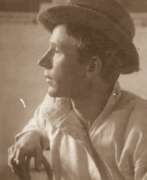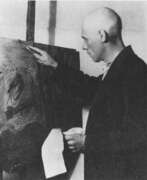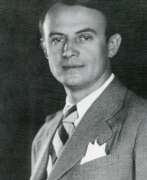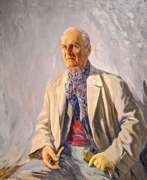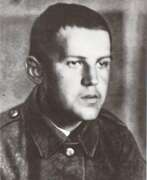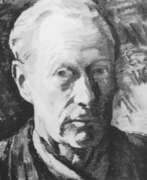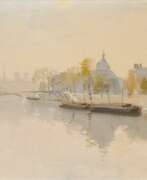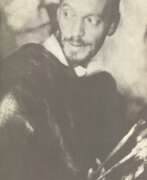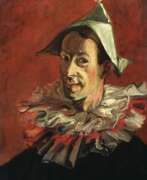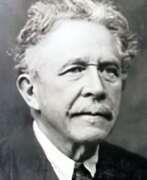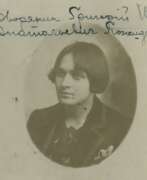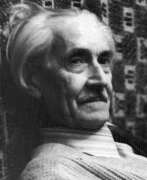Russian Empire Post-Impressionism


Lydia Ivanovna Arionescu-Baillayre (Russian: Лидия Ивановна Арионеско-Балльер) was an early twentieth-century Russian artist of Moldovan origin. She is known as a painter, a representative of Post-Impressionism and Neo-Impressionism.
Lydia Arionescu-Baillayre created still lifes and portraits. She was a member of the first St. Petersburg society of experimental and innovative artists "Union of Youth".


Abraham Adolf Behrman was a Polish artist of Jewish origin, best known for his paintings of Jewish shtetl life in the open air as well as landscapes and group portraits. He spent most of his life in Łódź and was killed during the liquidation of the Białystok ghetto during the Holocaust.


Alexandre Nikolayevich Benois (Russian: Алекса́ндр Никола́евич Бенуа́) was a distinguished Russian artist, art critic, and historian, celebrated for his pivotal role in the art world, particularly in painting and stage design. Born into a family deeply embedded in the cultural fabric of Russia, Benois was instrumental in the development of the Russian artistic movement at the turn of the 20th century. His contributions to art and culture extend beyond his vivid paintings; he was a founding member of the World of Art (Mir iskusstva), a significant art movement and magazine that sought to elevate Russian artistry on the global stage.
Benois' work is notable for its intricate detailing, vibrant use of color, and the ability to convey deep narratives within each piece. His designs for ballets such as "Petrushka" and "The Sleeping Beauty" remain iconic, showcasing his mastery over the fusion of visual art and performance. This synthesis not only enhanced the ballets’ visual appeal but also deepened the audience's engagement with the narrative. Museums and galleries around the world, including the Russian Museum in St. Petersburg and the Tretyakov Gallery in Moscow, house his works, underscoring his global recognition and the enduring appeal of his artistic vision.
For collectors and experts in art and antiques, Benois' oeuvre represents a fascinating exploration of early 20th-century Russian culture, art, and the avant-garde movement. His ability to blend traditional Russian themes with the modernist trends of his time makes his work a valuable study in the evolution of modern art. Those interested in the rich tapestry of Russian cultural history and the interplay between art and performance will find Benois' contributions invaluable.
To stay informed about new discoveries, sales, and auction events related to Alexandre Nikolayevich Benois, we encourage you to sign up for updates. This subscription is tailored specifically for enthusiasts eager to deepen their appreciation and understanding of Benois' legacy, ensuring you're the first to know about opportunities to acquire pieces connected to this luminary of Russian art.
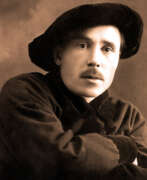

Alexei Nikolaevich Borisov (Russian: Алексей Николаевич Борисов) was a Russian and Soviet artist of the first half of the twentieth century. He is known as a painter, graphic artist, decorator, stage designer and teacher.
Alexei Borisov covered various themes in his work, from landscapes and portraits to works devoted to the partisan movement, industrialization and collectivization in Siberia, where the artist settled. His works, according to critics, stood out for their expressiveness, reverence, poetry and authenticity. The master left a significant creative legacy, including about 700 works of painting, graphics and decorative sketches.


Victor Elpidiforovich Borisov-Musatov (Russian: Ви́ктор Эльпидифо́рович Бори́сов-Муса́тов) was a distinguished Russian artist celebrated for his unique contribution to the Post-Impressionist movement, combining elements of Symbolism, realism, and a decorative style that was all his own. Born in 1870 in Saratov, Russia, into the family of a former serf, Borisov-Musatov overcame early challenges, including a spinal injury that left him humpbacked, to emerge as a pivotal figure in Russian art. His education spanned the Moscow School of Painting, Sculpture and Architecture, and the Imperial Academy of Arts in Saint-Petersburg, further enriched by studies in Paris under the tutelage of Fernand Cormon. His admiration for French contemporaries, especially Pierre Puvis de Chavannes and Berthe Morisot, profoundly influenced his artistic direction.
Borisov-Musatov is renowned for his lyrical, evocative works that often depict the serene and idyllic life of the 19th-century Russian nobility, set against the backdrop of their estates. This half-illusory world, which he masterfully created, reflects a deep nostalgia and a retreat from the industrial harshness of his time. By integrating figures seamlessly into the landscapes, as seen in masterpieces like "The Pool" (1902) and "The Phantoms" (1903), he achieved a harmony that resonates with viewers for its beauty and tranquility. His use of mixed media, including tempera, watercolor, and pastel, allowed for subtle visual effects, making his works distinctive in their soft, dreamlike quality.
Borisov-Musatov's legacy extends beyond his paintings; he was a significant figure in the Russian Symbolist movement and a founding member of the Moscow Association of Artists. His works, which provide a poignant, poetic commentary on the era he lived in, are celebrated in Russian and international art circles alike. Notable paintings like "The Pool" and "The Phantoms" not only highlight his technical skill but also his ability to evoke emotion and atmosphere, making them favorites among collectors and art enthusiasts.
For collectors and experts in art and antiques, Borisov-Musatov's oeuvre offers a fascinating glimpse into the Russian Symbolist movement and the broader cultural milieu of the late 19th and early 20th centuries. His works, preserved in museums and private collections around the world, continue to enchant and inspire.
For those interested in staying informed about new product sales and auction events related to Victor Elpidiforovich Borisov-Musatov, subscribing for updates is highly recommended. This subscription ensures that enthusiasts and collectors alike will not miss the opportunity to own a piece of this remarkable artist's legacy, encapsulating the elegance and serenity that define his work.


Isaac Aronovich Davidovich (Russian: Исаак Аронович Давидович) was a Soviet and Belarusian artist of Jewish origin of the second half of the twentieth century. He is known as a painter and graphic artist.
Isaac Davidovich worked in easel and monumental and decorative painting, as well as in easel and book graphics, he drew illustrations and posters. In the field of monumental art he created plafonds and panels.


Alexander Alekseevich Efimov (Russian: Александр Алексеевич Ефимов) was a Soviet artist of the mid-twentieth century. He is known as a battle painter, marinist and teacher.
Alexander Efimov participated in the Great Patriotic War and the main theme of his work was the history of the navy. He actively worked in the studio of marinists of the fleet, in his work he used the techniques of oil painting and watercolor. His works, including the paintings "Leningradki", "Sailors in the battles for Budapest", "Northern Fleet", became famous for their historical significance.
Efimov's works are in museums and private collections not only in Russia but also abroad.
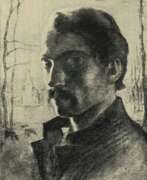

Robert Lvovich Genin (Russian: Роберт Львович Генин) was a Jewish-born artist of the first half of the twentieth century who worked in several countries, including the Russian Empire, Germany, France, Germany, Switzerland, and the USSR. He is known as a painter and graphic artist.
Robert Genin worked in a variety of genres including landscapes, portraits, genre compositions and nudes. He also did lithography, woodcuts and etching. His style evolved from Jugendstil and Symbolism in the early 1900s to Expressionism after the First World War. He later came to a kind of lyrical primitivism. The artist worked in both easel and monumental painting and was influenced by various artists.
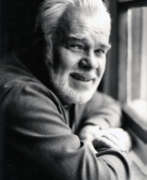

Vitaly Nikolaevich Goryaev (Russian: Виталий Николаевич Горяев) was a celebrated Soviet graphic artist, illustrator, painter, and caricaturist, born on April 14, 1910, in Tobolsk province, and passed away on April 12, 1982, in Moscow. He embarked on his artistic journey after his family moved to Chita in 1921, where he first published his drawings in the local newspaper. Goryaev's notable achievements include first-degree diplomas at the All-Union Contests "Best Books" for his illustrations to "The Adventures of Huckleberry Finn" and Gogol's "Petersburg Stories". His work was also internationally recognized, evidenced by a diploma II degree at the International Book Exhibition in Bratislava in 1967 for "Petersburg Stories", and in 1969, he was awarded the Gold Medal of the Czechoslovak Union of International Relations. Goryaev's illustrations spanned works by Russian classics like Pushkin, Gogol, and Dostoevsky, contributing significantly to the visual representation of these literary giants' works.
A laureate of the State Prize of the USSR (1967) for his contributions to illustrating Gogol's "Petersburg Stories", Goryaev was honored with the title of People's Artist of the RSFSR in 1976, and later, People's Artist of the USSR in 1981, marking his significant contributions to Soviet art. His legacy includes a profound impact on the illustration of literature, with his works being housed in prestigious collections such as the State Tretyakov Gallery, the Russian Museum, and the Pushkin Museum of Alexander Pushkin.
Goryaev's style was known for its expressive detail and ability to capture the essence of the literary works he illustrated, making his art an integral part of Soviet visual culture. His son, Sergei Vitalevich Goryaev, continues the artistic lineage as an artist, preserving the family's contribution to Russian art.
For collectors and experts in art and antiques, Goryaev's works represent a unique intersection of Soviet history, literature, and visual arts, offering a glimpse into the rich cultural tapestry of the era. His illustrations are not only important for their artistic value but also for their historical significance, embodying the spirit and challenges of Soviet society.
To stay updated on events, sales, and auctions related to Vitaly Nikolaevich Goryaev's work, sign up for updates. This subscription ensures you remain informed about opportunities to acquire pieces of this influential artist's legacy, highlighting moments when his works become available in the market.
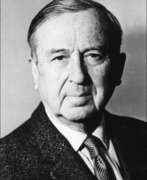

Mykola Petrovich Hlushchenko, a prominent Ukrainian post-impressionist painter, was born in 1901 in Novomoskovsk, Russia, and is celebrated for his diverse artistic contributions that span across various European landscapes, still life, nudes, and notable portraits. His early exposure to art in Yuzivka (now Donetsk), and further education at the Academy of Art in Berlin in 1924, laid the foundation for his illustrious career. Hlushchenko's work caught the attention of French critics soon after he moved to Paris in 1925, marking his transition from the New Objectivity style to post-Impressionism.
Hlushchenko's involvement with the Association of Independent Ukrainian Artists in the early 1930s, and his exhibitions across major European cities and the United States, underscored his role as a leading figure in Ukrainian post-impressionism. His work was characterized by vibrant color use and a unique blend of styles influenced by his time in Germany, France, and later in the Soviet Union. Throughout his life, Hlushchenko's art reflected his extensive travels and deep appreciation for landscapes, earning him numerous awards including the Shevchenko National Prize in 1972.
For art collectors and enthusiasts, Hlushchenko's pieces not only represent the zenith of Ukrainian post-impressionism but also embody the artist's rich, multifaceted life experiences. His paintings, such as the portraits of Oleksandr Dovzhenko and Volodymyr Vynnychenko, along with commissioned works for the Soviet government, showcase his adaptability and mastery over his medium.
To stay informed on Mykola Petrovich Hlushchenko's works and related auction events, signing up for updates is advisable. This subscription ensures you're always in the loop for new sales and exhibitions, enriching your collection with the vibrant legacy of a distinguished Ukrainian artist.
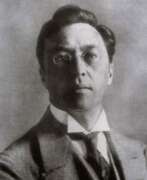

Wassily Wassilyevich Kandinsky (Russian: Василий Васильевич Кандинский) was a trailblazer in the art world, known for his pioneering role in the development of abstract art. Born in Moscow, Russia, in 1866, Kandinsky embarked on a journey that would take him from the study of law and economics to becoming one of the most influential artists of his time. His journey into the arts began at 30, a significant shift from a promising career in law to attending the Academy of Fine Arts in Munich. This decision marked the start of a profound exploration of color, form, and the spiritual in art.
Kandinsky's work is celebrated for its innovative use of color and abstract forms, with notable pieces such as "Composition VII" and "On White II" showcasing his ability to evoke emotional resonance through non-representational means. His art was not just about visual aesthetics but also aimed to touch the spiritual and emotional realms of the viewer. He often compared his method of painting to composing music, emphasizing the emotional power of abstract forms and colors. This philosophy was reflected in his theoretical writings, notably in "Concerning the Spiritual in Art," where he laid out his beliefs about the role of art and the artist in society.
Throughout his career, Kandinsky was involved with several avant-garde groups, including Der Blaue Reiter and Die Blaue Vier, collaborating with other influential artists of the time like Paul Klee and Alexej Jawlensky. After the Bauhaus school, where he taught, was closed by the Nazis, Kandinsky moved to France, where he spent the remainder of his life, continuing to evolve his style and contribute to the art world until his death in Neuilly-sur-Seine in 1944.
Kandinsky's legacy is not only in his artworks, which are held in esteemed collections worldwide, such as the Solomon R. Guggenheim Museum in New York, but also in his impact on the course of modern art. He opened up new possibilities for artists by demonstrating that art could venture beyond the representational and delve into the purely abstract, exploring the inner emotional and spiritual life through form and color.
For those captivated by Kandinsky's revolutionary approach to art and interested in the evolution of abstract expression, signing up for updates on new product sales and auction events related to Kandinsky's work is an excellent way to stay informed. This subscription service is tailored for collectors and art experts, ensuring you are the first to know about opportunities to acquire pieces by or related to this groundbreaking artist.
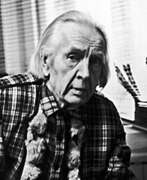

Alexander Petrovich Koroviakov (Russian: Александр Петрович Коровяков) was a Soviet and Russian artist of the second half of the twentieth century. He is known as a painter, a representative of the Leningrad school.
Alexander Koroviakov worked in the genres of portraiture, landscape, genre compositions and still life. His artistic vision was emphasized on the Leningrad landscape and writing from nature. The master experimented with various painting techniques to create works with a volumetric and multi-layered effect.
His works are in museums and private collections in Russia, England, Belgium, USA, France and other countries.
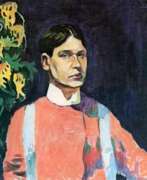

Aristarkh Vasilyevich Lentulov (Russian: Аристарх Васильевич Лентулов) was a prominent figure in Russian avant-garde art, celebrated for his distinctive use of color and innovative approach to Cubism. Born in Nizhneye Lomovo, Penza oblast, Russia, in 1882, Lentulov's early years were spent in a religious family, setting a foundation that would influence his rich and vibrant artistic style. His education at the art institutes in Penza and Kiev, followed by his studies under Dmitry Kardovsky in St. Petersburg, prepared Lentulov for a groundbreaking artistic career.
Lentulov's artistic journey took a significant turn when he moved to Paris in the winter of 1911. There, he was exposed to the works of leading French Cubists at the Académie de la Palette, including Henri Le Fauconnier. This period marked Lentulov's deep dive into Cubism and Orphism, influenced by his interactions with avant-garde artists such as Jean Metzinger, Albert Gleizes, and Fernand Léger. Upon his return to Russia, he became one of the founders of the Jack of Diamonds, a group that exhibited artists with "leftist tendencies" and embraced foreign, mostly French Cubists.
Lentulov's style uniquely combined the spatial concepts of Cubism with the vibrant colors of Fauvism, drawing on Russian folk art to create compositions that were both innovative and deeply rooted in Russian culture. His works, characterized by their luminous color and dynamic composition, played a significant role in the development of Russian Futurism and Cubo-Futurism. Notably, his involvement in theatrical projects, including set designs for the Kamerny Theatre and the Bolshoi Theatre, highlighted his versatility and creative genius.
Aristarkh Lentulov's legacy is preserved in his contributions to the avant-garde movement, and his works continue to be celebrated for their bold experimentation and vibrant expression. His paintings, such as "Saint Basil's Cathedral" and "The Belfry of Ivan the Great," are held in high esteem, showcasing his ability to capture the essence of Russian architecture and culture through a modernist lens.
Art enthusiasts and collectors recognize Lentulov as a pivotal figure in the evolution of modern Russian art. His innovative techniques and bold use of color have cemented his place in art history as a master of Russian avant-garde.
For updates on exhibitions and auction events featuring Aristarkh Vasilyevich Lentulov's work, sign up for our newsletter. Stay informed about the latest sales and opportunities to add a piece of Russian avant-garde history to your collection.


Sonia Lewitska (Ukrainian: Sofia Pilipivna Lewitska) was a Ukrainian émigré artist who worked in Paris. She is known for her paintings and drawings in the styles of Cubism and Post-Impressionism with the influence of Ukrainian folk art.
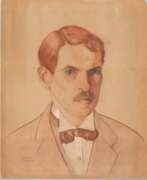

Sergey Ivanovich Lobanov (Russian: Сергей Иванович Лобанов), a Russian painter born in 1887 and whose legacy extended until 1942, is renowned for his captivating landscapes and insightful portraiture. Lobanov's artistry is marked by his adept use of color and form, capturing the essence of the Russian landscape and the soul of its people. His contributions to Russian art are notable, with several works like "River Rapids, 1922" and "View of Justinian's Tower, Feodosia, 1926" highlighting his mastery in landscape painting. These pieces, among others, demonstrate Lobanov's unique ability to blend realism with a sense of the mystical, making the mundane majestic.
Lobanov's career was interspersed with significant accomplishments, including his involvement with the "Jack of Diamonds" group, an avant-garde artists' association. Additionally, his role as a curator and senior curator for the first State Museum of New Western Painting (GMNZh) in the early 1920s underscores his influence beyond the canvas. This period was marked by his dedication to documenting and promoting art, as well as creating it. Lobanov's work during this time not only contributed to the preservation of art but also to the cultural heritage of Russia.
His art continues to be celebrated for its contribution to the Russian avant-garde movement, capturing moments of Russian history and landscape with a vividness that speaks to the depth of his artistic vision. Lobanov's works are a testament to his skill, passion, and the intricate relationship between artist and environment.
For collectors and experts in art and antiques, Sergey Ivanovich Lobanov's oeuvre offers a glimpse into the soul of Russia through its landscapes and historical moments. We invite you to sign up for updates on sales and auction events related to Sergey Ivanovich Lobanov, ensuring you stay informed about opportunities to own a piece of Russian art history.


Ilya Ivanovich Mashkov (Russian: Илья Иванович Машков) was a Russian artist, renowned for his vivid and sensory-rich paintings, embodying the essence of Russian Neo-Primitivism. His journey began in the village of Mikhailovskaya, propelling from a humble background to becoming one of the most significant figures in the "Jack of Diamonds" group. His works are celebrated for their tangible, almost tactile quality, drawing viewers into a vivid world where colors pop and forms pulse with life.
Mashkov's notable participation in significant exhibitions across Europe and the United States, including the Salon d'Automne and the Venice Biennale, helped cement his status in the art world. One of his masterpieces, "Still Life with Fruit," fetched a record $7.3 million at a Christie's auction in 2013, underlining his critical and commercial acclaim. This painting, a prime example of Russian Neo-Primitivism, was unveiled at the inaugural Jack of Diamonds exhibition, highlighting Mashkov's pioneering role in Russian Avant-Garde.
Mashkov's contributions extended beyond his canvas; he was a dedicated educator, establishing his art school and later teaching at VKhUTEMAS. His influence is palpable in the collections of major museums, including the Russian Museum, which houses a diverse array of his works from vibrant still lifes to expressive portraits.
For collectors and experts in art and antiques, Mashkov's legacy offers a captivating glimpse into the evolution of Russian modernism. His works, characterized by their bold coloration and dynamic composition, continue to inspire and attract admiration worldwide.
To stay updated on sales and auction events featuring Ilya Ivanovich Mashkov's work, signing up for updates is highly recommended. This ensures you're always informed about the latest opportunities to acquire pieces by this master of Russian Neo-Primitivism.
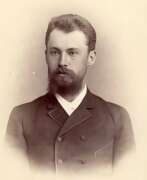

Nikolai Vasilievich Mescherin (Russian: Николай Васильевич Мещерин) was a Russian artist and entrepreneur born on February 28, 1864, in Moscow, and died on October 22, 1916, in Meshcherino, Russia. Known primarily for his landscape paintings, Mescherin initially embraced Impressionism, later experimenting with Pointillism, a technique developed by French Neo-Impressionists. His lyrical landscapes, often rendered in pastel, capture the serene beauty of Central Russia.
Mescherin was also a co-owner of the Moscow Danilovskaya Manufactory, balancing his industrial pursuits with his artistic endeavors. His works are significant for their emotional depth and technical precision, distinguishing him in the Russian art scene of the late 19th and early 20th centuries. Some of his notable works are housed in the Museum of Russian Impressionism in Moscow, where they continue to attract admiration from art enthusiasts and collectors.
For those interested in exploring more about Nikolai Vasilievich Mescherin's life and works, signing up for updates on new product sales and auction events related to his art is highly recommended. Stay informed about the latest opportunities to acquire pieces from this remarkable artist's collection.
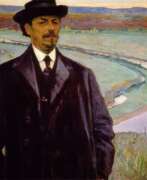

Mikhail Vasilyevich Nesterov (Russian: Михаи́л Васи́льевич Не́стеров), a distinguished Russian artist, was renowned for his unique contributions to the realms of painting and art, epitomizing the spiritual and cultural ethos of his era. Born into the vibrant milieu of pre-revolutionary Russia, Nesterov carved a niche for himself with his profound spiritual themes and innovative artistic techniques. His work, deeply rooted in Russian Orthodox traditions, reflects a meticulous blend of realism and symbolism, capturing the essence of Russian culture and spirituality.
Nesterov's artistry is celebrated for its ethereal quality, marked by a distinctive use of color and light to evoke a sense of divine presence. Among his most acclaimed works is the series on St. Sergius of Radonezh, a revered Russian saint, which not only showcases his technical prowess but also his ability to weave spiritual narratives into visual art. These pieces, housed in prestigious museums and galleries, continue to captivate art enthusiasts and collectors worldwide.
His legacy extends beyond his paintings, influencing generations of artists and imbuing Russian culture and art with a profound spiritual dimension. Nesterov's ability to transcend the mundane through his art renders his work timeless, making it a subject of study and admiration among experts in art and antiques.
For collectors and connoisseurs keen on exploring the rich tapestry of Russian art, Nesterov's oeuvre offers a window into the soul of Russia. We invite you to sign up for updates on new product sales and auction events related to Mikhail Vasilyevich Nesterov, ensuring you stay informed about opportunities to own a piece of this legendary artist's legacy. This subscription is your gateway to the world of art and culture, tailored specifically for those who appreciate the profound beauty and spiritual depth of Nesterov's work.


Vasili Rozhdestvensky (Russian: Василий Васильевич Рождественский) was a Russian artist, born in Tula in 1884, who diverged early from classical to modernist trends in painting, including Impressionism. His father, a priest, initially aimed for him to follow a religious path, but Rozhdestvensky's talent in art, recognized by his art teacher L. Samygin, led him to pursue his passion for painting. At 16, he moved to Moscow and enrolled in the Moscow School of Painting, Sculpture, and Architecture, where he was mentored by notable artists such as Konstantin Korovin and Valentin Serov. Rozhdestvensky is celebrated for his contributions to modernist still life and landscape painting, as well as graphic art. His work reflects a transition from classical styles to embracing the innovations of modern art, making significant contributions to the Russian avant-garde movement.
Throughout his career, Rozhdestvensky participated in various exhibitions, showcasing landscapes inspired by Impressionism alongside his modernist peers. His art is known for its vivid portrayal of natural and still life scenes, which have been highly regarded at auctions and by collectors worldwide. Vasili Rozhdestvensky's legacy includes a diverse body of work that spans modernist still life, landscape painting, and graphic art, illustrating his versatility and profound impact on the art world. His works continue to be sought after, with auction records reflecting the enduring value and appreciation of his artistic contributions.
For collectors and experts in art and antiques, Vasili Rozhdestvensky's works represent a unique blend of Russian cultural heritage and modernist innovation. His paintings not only capture the beauty of the Russian landscape and everyday objects but also embody the spirit of a pivotal era in art history. To stay updated on new sales and auction events featuring Vasili Rozhdestvensky's works, consider signing up for updates. This subscription will ensure you're informed about opportunities to acquire pieces by this influential Russian modernist.
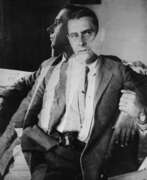

Aleksandr Vasilievich Shevchenko (Russian: Александр Васильевич Шевченко) was a Ukrainian modernist painter and sculptor, whose career spanned from the late 19th to the mid-20th century. Born in Kharkiv in 1882 and passing away in Moscow in 1948, Shevchenko's educational journey took him from private drawing lessons in his youth to prestigious art institutions in Moscow and Paris, where he honed his skills under the tutelage of renowned artists like Valentin Serov and Konstantin Korovin.
Shevchenko's artistic journey was marked by his involvement with avant-garde movements and his contributions to art theory. He explored and experimented with Neo-Primitivism and Rayonism, engaging with the avant-garde community through exhibitions and theoretical works. Notably, his time in Paris allowed him to interact with influential circles that included Mikhail Larionov and members of the Academy Julian.
Shevchenko's legacy is preserved in the Pushkin State Museum of Fine Arts, the State Tretyakov Gallery, and the State Russian Museum, among others. His work from the 1920s onward reflects a blend of experimental and traditional techniques, exploring themes of Russian folk art and oriental influences, which he believed were the origins of Russian art.
For art collectors and enthusiasts, Aleksandr Vasilievich Shevchenko's body of work offers a rich exploration of modernist themes and a bridge between traditional Russian art and avant-garde movements. His contributions to both the practical and theoretical aspects of art make him a pivotal figure in understanding the evolution of Russian modernism.
To stay updated on sales and auction events related to Aleksandr Vasilievich Shevchenko's work, sign up for our newsletter. This subscription will keep you informed about new discoveries and opportunities to acquire pieces by this influential artist.


Sergei Fedorovich Shishko (Russian: Сергей Фёдорович Шишко) was a distinguished Soviet painter, renowned for his profound contributions to the landscape and still-life genres of art. Born in 1911 in the town of Nosivka, Ukraine, Shishko's early exposure to art in school laid the foundation for his lifelong passion. Despite the tumultuous backdrop of the Soviet regime, his works exhibited a distinct impressionistic flair, diverging from the state-sanctioned socialist realism of the time. His remarkable series of canvases, particularly those depicting Mariyinski Park and the Carpathian Mountains, showcase an exploratory spirit and a bold embrace of color and light, earning him acclaim far beyond the borders of his homeland.
Shishko's life was not without its trials; he navigated the complexities of Soviet politics and personal challenges with resilience, balancing his artistic endeavors with the demands of family life. His dedication was recognized through numerous awards, including the prestigious title of People's Artist of the USSR. Shishko's works, which continue to be celebrated for their vibrant depiction of Ukrainian landscapes and still lifes, reflect a deep-rooted love for his country and an unyielding commitment to artistic freedom.
His legacy extends beyond his paintings, serving as a testament to the power of art to transcend political and personal adversity. Shishko passed away in 1997, but his influence endures, with his masterpieces residing in museums and private collections worldwide, reminding us of the enduring beauty of the Ukrainian landscape and the indomitable spirit of its people.
For collectors and art enthusiasts interested in Sergei Fedorovich Shishko's work, signing up for updates can provide exclusive information on new product sales and auction events related to this remarkable artist. This subscription is a valuable resource for those keen to explore the depths of Shishko's artistic legacy and the ongoing influence of his work in the realms of art and culture.
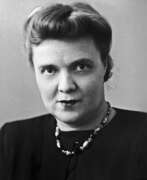

Elena Petrovna Skuin (Russian: Елена Петровна Скуинь) was a Soviet artist of the second half of the twentieth century. She is known as a painter, graphic artist, draftsman and teacher, a representative of the Leningrad school.
Elena Skuin wrote genre paintings, portraits, still lifes and landscapes. She worked in a variety of techniques including oil painting, watercolor and charcoal drawing. Her greatest successes were still lifes, and in the 1970s she came to be regarded as an outstanding watercolorist.
Her works reflected the beauty and aesthetics of everyday objects, giving them a soulful warmth.
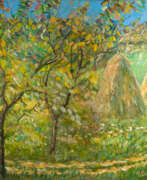

Pyotr Dorofeyevich Slyota (Russian: Пётр Дорофеевич Слёта) was a Ukrainian Soviet artist of the mid-twentieth century. He is known as a painter, famous for his thematic paintings and landscapes.
In his works, according to critics, Pyotr Slyota showed the best features of Soviet art - patriotism, humanism, love for nature. In his work an important place is occupied by works devoted to the history of Ukraine. In landscape works from different countries where the artist visited ("Street in Košice", "Charles Bridge", "Paris. Notre Dame"), he managed to reveal the national and social features of these cities.


Yevgeny Ivanovich Stolitsa (Russian: Евгений Иванович Столица) was a Russian and Soviet artist of the late 19th century and the first third of the 20th century. He is known as a painter and graphic artist.
Yevgeny Stolitsa is best known as a landscape painter. He also painted portraits, historical and battle paintings. His works are distinguished by a fine transmission of the light and air environment, a free impressionistic style of painting, rich and saturated colors with lots of nuances and shades. According to critics, unpretentious rustic motifs in the artist's portrayal acquired a special poeticism.
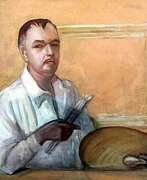

Sergey Yurievich Sudeikin (Russian: Сергей Юрьевич Судейкин), also known as Serge Soudeikine, was a Russian artist and set-designer renowned for his vivid contributions to the world of art and theater. Born on March 19, 1882, in Smolensk, Russia, and passing away on August 12, 1946, in Nyack, New York, Sudeikin's career was a testament to his versatile talent and innovative vision. He was closely associated with prestigious institutions such as the Ballets Russes and the Metropolitan Opera, showcasing his unique ability to blend artistic and theatrical design.
Sudeikin's journey in the arts began at the Moscow School of Painting, Sculpture and Architecture, where he was notably banned for his bold, "obscene drawings". This rebellious start led him to join the Mir Iskusstva (World of Art) movement, solidifying his place among Russia's avant-garde artists. His circle included significant figures like poet Mikhail Kuzmin and impresario Serge Diaghilev, highlighting his integral role in Russia's cultural scene before emigrating to the West.
Among Sudeikin's notable works are his set and costume designs for Diaghilev's production of "La tragédie de Salomé" and his collaboration on "The Rite of Spring". After moving to the United States, he continued to leave his mark on the theater world, with works like the set design for the original Broadway production of "Porgy and Bess". Sudeikin's style is recognized for its theatricality, vivid color use, and often incorporated themes of irony and tragedy, deeply influencing the visual arts and theater design of the 20th century.
His artwork, including famous pieces like "Carousel", "Venetian masquerade", and "Portrait of Nina Shik", can be found in galleries and private collections worldwide, highlighting his enduring appeal. Despite facing challenges in gaining widespread recognition during his lifetime, Sudeikin's contributions to art and theater have solidified his legacy as a pioneering artist and designer.
Collectors and experts in art and antiques continue to celebrate Sergey Yurievich Sudeikin's work for its innovative approach and historical significance. To stay updated on sales and auction events related to Sudeikin's work, signing up for updates is highly recommended. This ensures that enthusiasts and collectors alike do not miss out on the opportunity to own a piece of this remarkable artist's legacy.
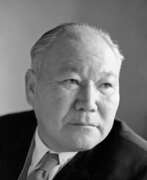

Ural Tansykbaevich Tansykbayev (Russian: Урал Тансыкбаевич Тансыкбаев) was a distinguished Uzbek painter of Kazakh descent, celebrated for his vivid and expressive works. Born on January 1, 1904, in Tashkent, Tansykbayev's artistic journey was profoundly influenced by Fauvism and French Expressionism, evident in his early work's increased decorativeness and vibrant use of color. His contributions to the Regionalist movement further defined his legacy, marking him as a pivotal figure in Uzbekistan's art history.
Throughout his career, Tansykbayev's art evolved, with a significant shift in the 1950s towards landscape painting, which became the main genre of his later works. His talent and contributions were recognized with numerous governmental awards, including the prestigious Order of Lenin and the Hamza State Prize of the Uzbek SSR in 1973. Tansykbayev's works are cherished globally and can be found in several museums, including the Ural Tansykbayev Memorial Museum in Tashkent, the State Tretyakov Gallery in Moscow, and the State Museum of Oriental Art, also in Moscow.
The Ural Tansykbayev Museum in Tashkent, established by his widow, Elizaveta Tansykbayeva, serves as a testament to his life and work. Opened in 1981, the museum houses not only his paintings but also the artist's studio, offering a personal glimpse into his creative world. This museum stands as a cultural landmark, celebrating the legacy of a man who significantly impacted Uzbek and Soviet art.
For collectors and art experts interested in Tansykbayev's profound and colorful works, signing up for updates on new product sales and auction events related to Ural Tansykbayev is highly recommended. This subscription ensures you stay informed about opportunities to own a piece of this legendary artist's legacy.


Vladimir Evgrafovich Tatlin (Russian: Владимир Евграфович Татлин) was a pioneering Russian and Soviet avant-garde artist, architect, and designer, celebrated for his innovative contributions to modern art, sculpture, and architecture. Born in Moscow, Tatlin's work transcended traditional boundaries, blending art with technology and ideology in a way that was revolutionary for his time. His dedication to merging functional design with artistic vision marked him as a key figure in the Constructivist movement, which sought to apply art to practical and social purposes.
Tatlin is best known for his ambitious but never-realized project, the Monument to the Third International, commonly referred to as Tatlin's Tower. This monumental structure, intended to serve as the headquarters for the Comintern in Petrograd, symbolized the utopian aspirations of the Soviet Union in the early 1920s. The tower's design, featuring a spiraling iron frame reaching 400 meters in height, embodied the avant-garde's commitment to innovation and the belief in art's power to shape a new societal order. Though it remained unbuilt, the tower's visionary design continues to influence architects and artists worldwide.
Beyond Tatlin's Tower, his contributions to the world of art include significant works in painting and sculpture. His approach to material and form, particularly his counter-reliefs, challenged traditional artistic conventions and opened new avenues for exploration in modern art. Tatlin's legacy extends to educational realms as well, where his tenure at the Moscow Vkhutemas (the Higher Art and Technical Studios) helped shape a generation of artists and designers. His works are preserved in major museums and galleries around the globe, serving as a testament to his enduring influence on culture and art.
For collectors and experts in art and antiques, Vladimir Tatlin's oeuvre represents a pivotal moment in the evolution of modernist expression. His innovative spirit and radical designs continue to inspire and provoke. If you wish to stay informed about new discoveries, sales, and auction events related to Vladimir Evgrafovich Tatlin, we invite you to sign up for our updates. This subscription is an excellent opportunity for enthusiasts and collectors to stay ahead in the dynamic world of art and antiques.
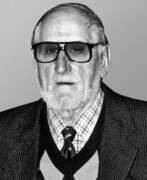

Rostislav Ivanovich Vovkushevsky (Russian: Ростислав Иванович Вовкушевский) was a Soviet and Russian artist of the second half of the twentieth century. He is known as a painter, muralist and teacher, a representative of the Leningrad school.
Rostislav Vovkushevsky actively exhibited his works since 1949. He worked in both easel and monumental painting, his work included still lifes, portraits, landscapes and genre compositions. Important works of the artist were monumental panels, mosaic compositions and ceremonial curtains for auditoriums. His style was distinguished by decorative elements, clear silhouettes and rich color, as well as rhythmic organization of the canvas.
His works are in museums and private collections around the world.
